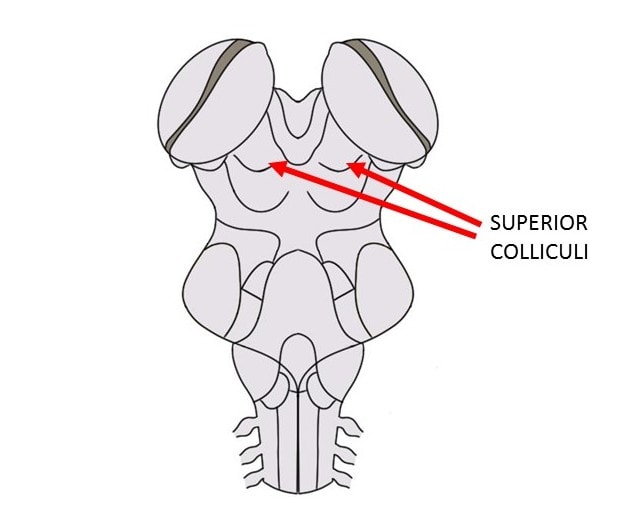Know Your Brain: Superior Colliculus
Where is the superior colliculus?

There are two superior colliculi in the midbrain. They are symmetrically positioned, one on either side of the midline of the brainstem; they form two bumps on the posterior external surface of the brainstem. The superior colliculi are just below the thalamus and above the two inferior colliculi. The superior colliculus is often referred to as the tectum or optic tectum in non-human vertebrates.
What is the superior colliculus and what does it do?
Although the complete scope of functions that can be attributed to the superior colliculi has not been fully delineated, the superior colliculi are understood to be important to directing behavioral responses toward stimuli in the environment. In other words, the superior colliculus seems to be able to receive information from the environment and then use that information to initiate a behavioral response appropriate to the current environmental context. For example, if you were sitting in the stands at a baseball game and someone hit a home run, you would follow the ball with your head and eyes. This behavioral response to an environmental stimulus would involve the superior colliculi. In fact, eye and head movements like this are the most-studied function of the superior colliculus, but the structure is thought to be involved in a variety of other responsive movements as well.
The superior colliculus is made up of several layers of cells, which anatomists have divided into what are called superficial and deep layers. The superficial layers seem to primarily receive visual information from the retina and the visual cortex, while the deep layers receive information from the auditory, visual, and somatosensory systems. The deep layers also appear to be where the motor functions of the superior colliculus originate, as stimulation of neurons in these layers can produce a variety of movements.
The different layers of the superior colliculi contain what are known as topographic maps for the sense modalities they process information from. The term topographic map in neuroscience is used to refer to an organization where sensory input from a particular region of the body is sent to a specific area of the central nervous system. For example, information from a particular part of the visual field is sent to a corresponding region of the superficial layers of the superior colliculus. Because all of the layers of the superior colliculus have a similar topographic arrangement, it allows for the rapid integration and enhancement of signals that arrive via multiple sense modalities (e.g. vision and hearing). Additionally, because the motor areas of the superior colliculus have the same topographic arrangement as the sensory areas, it allows for the rapid initiation of motor responses to incoming sensory information.
In many other vertebrates (e.g. fish, birds), the superior colliculus is one of the largest brain regions. In humans this is not the case, as it is dwarfed by a number of other structures. Despite its relatively small size, however, the superior colliculus plays a very important role in integrating sensory information and quickly triggering behavioral reactions to it.
Reference (in addition to linked text above):
King AJ. The Superior Colliculus. Current Biology. 2004;14(9):R335-8.


